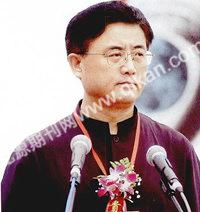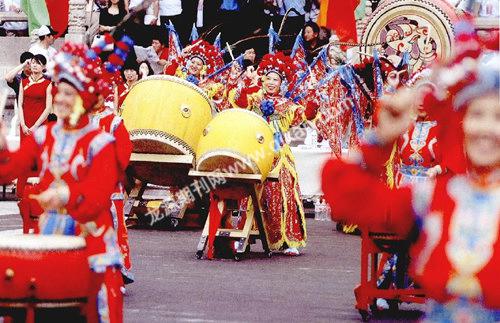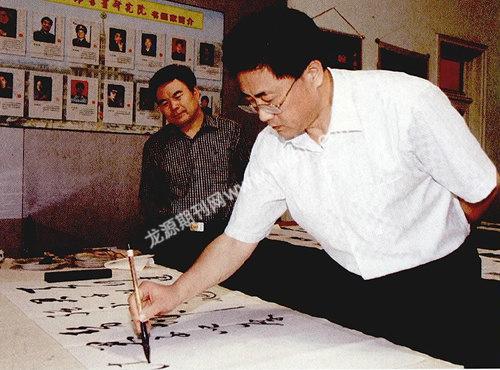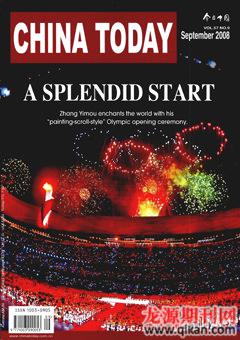Let Chinese Calligraphy Go Global
LU RUCAI
One hot summer day not long ago, in the central courtyard of the Temple of Imperial Ancestors in Beijing, 30 Chinese and foreign calligraphers could be seen working on a 100-meter-long scroll they were preparing for the Beijing 2008 Olympic Games.
The occasion was the opening ceremony of the Eighth International Calligraphy Exchange Exhibition, organized jointly by the China Federation of Literary and Art Circles (CFLAC), the Chinese Calligraphers Association (CCA) and the Beijing Municipal Federation of Literary and Art Circles.

Nearly 600 entries from 18 countries, including China, Japan, Singapore, the Republic of Korea, Malaysia, France and the United States were on display, and the exhibits were in Chinese, Japanese, Korean, Arabic and the scripts of Chinese ethnic minorities.
China originated the calligraphic arts, and Chinese calligraphy has a devoted following among the broad masses of ordinary Chinese. In parks, senior citizens can frequently be seen practicing their calligraphy using writing brushes the size of mops, and calligraphy works have recently fetched record high prices at auctions. In 2007, for example, a caoshu (cursive scripts) calligraphy work from the early Qing Dynasty, entitled Poetry Scroll, was sold for RMB 16.91 million, a new record that year. However, in the era of computers calligraphy faces unprecedented challenges to its popularity among younger generations.
As a non-governmental organization of calligraphers, the Chinese Calligraphers Association has made it its core mission to promote calligraphy among ordinary people, and to assist its dissemination worldwide. Recently, Zhao Changqing, vice president of the CCA, accorded an interview to China Today in which he expressed his belief that Chinese calligraphy has a brilliant future, both at home and abroad.

An Art for Everyone
China Today: What is you opinion of China as a calligraphy powerhouse?
Zhao Changqing: Calligraphy is an art form with deep roots among the broad masses of the people. The Chinese Calligraphers Association was founded in 1981 as a non-governmental organization for calligraphers. At present, it has 37 group members and 9,000 individual members. Provincial-level calligraphers associations have 500,000-600,000 members, and prefecture-level associations have millions of members. In total, there are tens of millions of members nationwide. In many families, calligraphy is regarded as one of the first lessons children must be taught.
China Today: Compared with other art forms, why is calligraphy so popular with ordinary people?
Zhao Changqing: Calligraphy has a very long history in China, and it is closely linked to Chinese written characters. Unlike other art forms, which require special venues, tools, skills and equipment, calligraphy only requires paper and a writing brush. In addition, practicing calligraphy can cultivate ones moral character. To many people, it is a kind of spiritual sustenance.

Currently, there are tens of millions of calligraphy lovers. In ancient China, when the imperial examination system was practiced, a mastery of calligraphy was a prerequisite for entering into official service. Even in modern times, a good mastery of calligraphy is regarded as a sign of good breeding. People are able to judge a persons scholarly attainments and accomplishment in self-cultivation from his or her handwriting.
Popularizing Calligraphy
China Today: The widespread use of computers has turned more and more young people away from writing by hand. Has that had any negative consequences for calligraphy?
Zhao Changqing: Indeed, the widespread use of computers has engendered certain problems for the further development of calligraphy. As it enters the information age, calligraphy faces a host of new challenges. Many children spend a great deal of time on computers, and they seldom write with pens, let alone brushes. As time passes, the younger generations are forgetting Chinese traditions and are not mastering calligraphy.
The two most representative aspects of traditional Chinese culture are the spoken and written language. Although Chinese characters are pictographs, each character has a profound meaning. Without actually writing them down, children cannot grasp their rich connotations, and cannot capture their essence. Deprived of that experience, children risk gradually becoming indifferent to traditional culture. The issue deserves our close attention.
China Today: Do you think practicing calligraphy helps children appreciate traditional culture?
Zhao Changqing: Absolutely. Calligraphy is one of the representative forms of traditional Chinese culture, and as calligraphy works are mostly poems and epigrams, they help educate young people.
China Today: Should China popularize calligraphy education in primary and middle schools?
Zhao Changqing: We have intensified our efforts to popularize calligraphy in primary and middle schools. At present, primary and middle schools in Guangdong Province and Chongqing Municipality have made calligraphy a required course. We are promoting their experiences, and hoping that calligraphy can be made an obligatory course for primary and middle school students nationwide.
The Chinese Calligraphers Association has also taken certain other measures, such as mobilizing calligraphers to donate to a fund to build Lanting Primary Schools, so named because calligraphy is a required course at these schools. Currently, four such schools have been built in Wuzhong City, in Ningxia Hui Autonomous Region, and in Huaian City, in Jiangsu Province, with funds donated by the Chinese Calligraphers Association. In addition, we plan to donate funds to build two Lanting schools in Wenchuan and Mianzhu, both of which were hit by the May earthquake, and which will be earthquake proof. Contact work is already underway.
Together with the Education Society of China, we have launched an activity called “learn to write good Chinese characters from childhood, and grow up to be a good Chinese citizen.” We aim to organize children to practice calligraphy. In addition, together with the organization mentioned above, we have sponsored the National Calligraphy Festival of Primary and Middle School Students. This is the festivals second year. Through these activities we try to promote calligraphy in schools and classrooms, and among children in general.
As an association of calligraphers, we feel our capabilities sometimes fall short of our wishes to promote calligraphy in schools. It would be much easier for the educational department to make calligraphy an obligatory course for primary and middle schools.
China Today: As an association of calligraphers, what other work have you done to promote calligraphy?
Zhao Changqing: We have launched a program called “Chinese calligraphy enters millions of families,” to urge calligraphers to visit schools, communities, villages and enterprises. During festivals and holidays, they present spring couplets to people as gifts. This activity is popular among calligraphers and ordinary people alike, and proves that calligraphy is popular among the broad masses of the people. Therefore, it has an excellent foundation to broaden its appeal further.
In addition, we have identified a number of cities and towns famous for calligraphy. Currently, five cities renowned for calligraphy have been named — Suzhou and Xuzhou in Jiangsu Province, Kaifeng and Anyang in Henan Province, and Shao-xing in Zhejiang Province.
We have also named 10 hometowns of calligraphy, among them Wenshang in Shandong Province, and Huaian in Jiangsu Pro-vince. The initiative aims to include calligraphy in the process of building a spiritual civilization, and into overall plans for economic and cultural development. Naming cities famous for calligraphy goes a long way toward promoting the art form.
Let Chinese Calligraphy Go Global
China Today: Many foreigners do not understand the Chinese language, but Chinese calligraphy is nevertheless very popular abroad. Why is that?
Zhao Changqing: Many famous people in the West have shown a great interest in Chinese calligraphy. Jacques Chirac, the former French president, remarked that Chinese calligraphy is the “art of arts,” that is, the highest of all art forms. Pablo Picasso, one of the most influential artists of the 20th century, once said that had he been born in China, he would have been a calligrapher instead of a painter.
China originated calligraphy, and calligraphy is the most representative element of traditional Chinese culture. Many foreigners do not understand the Chinese language, but they can appreciate Chinese calligraphy. Those who do not understand the Chinese language can easily understand Chinese paintings, such as landscape paintings and bird-and-flower paintings. But calligraphy is different. It has many pictographs and extended meanings. Foreigners are deeply interested in the abstract linear art of Chinese calligraphy. In many Asian countries, such as Japan and the Republic of Korea, their cultures have had interactive relations with traditional Chinese culture since ancient times, and calligraphy has always flourished. Experience has shown that the more national an art form is, the more global it is.
China Today: Do calligraphy lovers abroad have their own organizations?
Zhao Changqing: In many foreign countries there are Chinatowns, which are permeated with the aura of traditional Chinese culture. We can say that wherever there are Chinese people, there is Chinese culture, and wherever there is Chinese culture, there is Chinese calligraphy. And organizations of calligraphers exist from Australia to Canada, and New Zealand to Southeast Asia.
In 1988, the International Congress of Chinese Calligraphy was founded in Singapore, which is a world organization for calligraphers. Now its headquarters has been shifted to China, to be presided over by the Chinese Calligraphers Association. We plan to change its name to the International Federation of Calligraphers Associations. For now, it has 16 member units, but that number will grow in the future.
China Today: What methods have been adopted by the Chinese Calligraphers Association to promote Chinese calligraphy internationally?
Zhao Changqing: More and more people have begun to understand Chinese culture and developments in China through Chinese calligraphy, and many people have begun to appreciate China through Chinese calligraphy. It has an imperceptible influence. In addition to the initiative we call “Chinese calligraphy enters millions of families,” we have carried out a plan called “a global tour of Chinese calligraphy” and exhibited Chinese calligraphy in Australia, Southeast Asia and Africa. It was a complete success. Next, we will promote Chinese calligraphy in Europe.
The Chinese Calligraphers Association also often holds exhibitions abroad, to promote international exchange. One example is the 19th China-Japan Calligraphy Exhibition of Self-composed Poetry. I should emphasize that judging by the development momentum of calligraphy, one need not worry that calligraphy will die out with the popularization of computers. On the contrary, this ancient art form will continue to show its artistic appeal, and will retain its popular following into the distant future.
- CHINA TODAY的其它文章
- BASIC CHINESE FOR THE BEIJING 2008 OLYMPIC GAMES
- Discover the Han Heritage in Xuzhou
- Seventy Years Later,James Hilton’s Shangri-la Rediscovered
- Innovation and Excellence:Tianjin University of Finance and Economics
- The Development of an Agricultural City
- The Pig Breeding Industry Benefits Anhui Farmers

